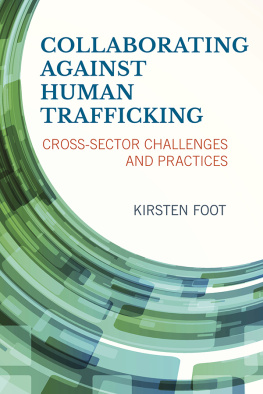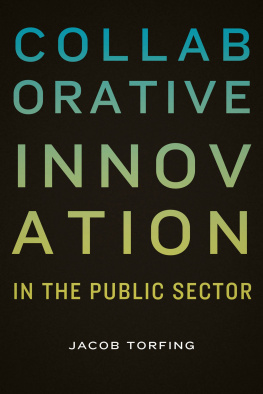Kirsten Foot has tackled the most important aspects of how to achieve effective collaboration in the complex and multifaceted efforts to end the slavery of human beings. She has identified the factors that must be addressed for different sectors to understand their contributions to accomplishing the common goal. May the book bring forth understanding among government offices, law enforcement, social service agencies, advocates and others to press on in this important effort togetherto save many precious lives from this horrific crime. Donna M. Hart , former District Director, U.S. Department of Labor, Wage and Hour Division
Provocative, sensitive, and deeply reflective. This insiders account explores what it takes to combat human traffickingtogether. Foot aptly describes the challenges of partnering and the complex interplay of interpersonal dynamics, cross-sector norms, social forces, and competing values. She calls for the thoughtful cultivation of partnerships based on respect, trust, and perseverance. For those who are in it to end it, this is a valuable and timely contribution; for those interested in productive collaboration to combat human trafficking, it is a must-read. But be warned: Looking into this mirror upon our very human interactions may invoke discomfort. Dr. Luke Bearup , consultant, former Child Protection and Research Development Specialist, Asia Pacific Region, World Vision
Foot provides a rich and constructive review of the potential for public and private partnerships to combat human trafficking, including numerous examples of cross-sector initiatives led by NGOs, government agencies, foundations, grassroots volunteers, and even the presidents cabinet. She utilizes deep research and firsthand accounts to eloquently outline why best intentions at collaboration sometimes succeed, sometimes fade, and sometimes fail, as well as the reasons why power, funding, and competition can interfere. Collaborating against Human Trafficking offers hope and direction on how these necessary cross-sector partnerships can work at scale. Karen Olcott , Strategic Development & Innovation, T-Mobile USA; founder of Partnerships for Global Impact and The Freedom Movement
This book brilliantly documents the trials and tribulations that law enforcement and NGOs experience. In addition to insightfully identifying collaboration challenges, it will help improve partnerships by educating participants of any human trafficking task forcewhether it is just starting or has already been working togetheron what it takes to work together well. I highly recommend Foots work for everyone embroiled in or researching the issues surrounding collaboration to end human trafficking. Detective Sergeant Jon Daggy , Indianapolis Metropolitan Police Department, Human Trafficking Vice Unit
This book does an excellent job explaining some very real tensions that exist in collaborative anti-trafficking work, such as the tensions between faith-based and areligious organizations, or between those who are survivor-activists and those who are not. It captures the complex dynamics present in interorganizational collaboration in response to a social problem, including a discussion of power, race, gender, and value orientations that inform collaborator perspectives, yet are often missing from the discussion. Drawing from her own experiences and those of many others in the field, Foot has pulled together a resource of tremendous value to professionals, practitioners, and activists who are engaged in this work. Dr. Katherine R. Cooper , associate director of the Network for Nonprofit and Social Impact, Northwestern University
Foot has given the anti-trafficking community a monumental gift with this book. It is a powerful tool to guide more effective collaboration as well as catalyzing more coalitions and networks locally, regionally, and globally. Alex Sum , cofounder of Seattle Against Slavery and Founder of Human Rights Society
As a program officer for a family foundation that invests in counter-trafficking efforts, I have heardand madenumerous appeals for more partnership and collaboration among counter-trafficking stakeholders. However, until reading this book, I had not encountered much helpful insight or advice for making collaboration actually work. Kirsten Foots in-depth research uncovers and explains the inevitable tensions and dynamics that make collaboration so difficult; instead of naively wishing those difficulties away, she challenges anti-trafficking stakeholders to reflect on why these tensions exist and recommends attitudes and practices necessary to overcome them in pursuit of more effective solutions. Practitioners, policymakers, and donors serious about improving collaborative efforts will benefit from reading this book. Jeremy Floyd , program officer, Equitas Group
This is a must-read for any person or agency who is engaging, about to engage, or ready to disengage in an anti-trafficking collaboration. Foot provides a deep, rich, and realistic analysis of the many challenges, pitfalls, opportunities, and rewards that come with multisector collaboration in counter-trafficking efforts. This book underscores the necessity of these partnerships and, through her analysis, provides an array of tools, resources, and insights that can help make these challenging partnerships more dynamic, powerful, and successful. Maria A. Trujillo , former executive director of United Against Human Trafficking
Based on my experience managing several multisector partnerships for Microsoft, I find that Dr. Foots suggestions for improving collaborations are spot on. Since every business has a role to play in ending human trafficking, everyone in the private sectorand especially technology companies engaged with this issueshould read this book. Rane Johnson-Stempson , director, Microsoft Research Outreach
A unique and crucial perspective on antihuman trafficking efforts. Collaborations are the key to effectively addressing human trafficking domestically and internationally, as well as for securing funding for new and existing anti-trafficking coalitions. Foot replaces what has seemed like a mix of magic and luck with a more tenable roadmap for initiating and sustaining multijurisdictional alliances. Applying the insights from this book in new or existing collaborative efforts will enrich these partnerships and will mature coalition-building from magic to art form. This book serves as a practical reference for crafting more effective and sustainable collaborations against human trafficking and making the end of slavery a more achievable reality. Derek Marsh , deputy chief (Ret.), Westminster Police Department, CA, and cofounder of the Orange County Human Trafficking Task Force
Collaborating against Human Trafficking gave me greater insight into the forces at play that both foster and disrupt the partnerships I work with on a daily basis. Dr. Foots nuanced examinations about race, gender, and survivor leadership are of vital importance for everyone working in this field. Dr. Mar Brettmann , executive director of Businesses Ending Slavery and Trafficking
Foot has done a great service to the anti-trafficking movement here in the United States and around the world: She compellingly articulates what weve done right and where weve failed in using collaboration to end slavery. She calls out the inherent and often self-defeating power dynamics that emerge in collaborative settingsin particular, the pervasive and often systemic marginalization of trafficking survivors. This book invites leaders in the anti-trafficking movement to acknowledge and challenge the power dynamics, embrace the collaborative tensions, and seize the massive opportunities inherent in collaboration to achieve the outcome of advancing lasting human freedom. It is an essential read for everyone dedicated to ending modern day slavery. Jesse Eaves , policy director, Humanity United; former senior child protection policy advisor, World Vision U.S.
Next page










